Gaming Performance
The big question here is whether or not the CPU is going to be the bottleneck with the selected graphics card. As you'll see, the processor can be a limiting factor in the stock systems, depending on the game, but once we start overclocking everything begins to even out.

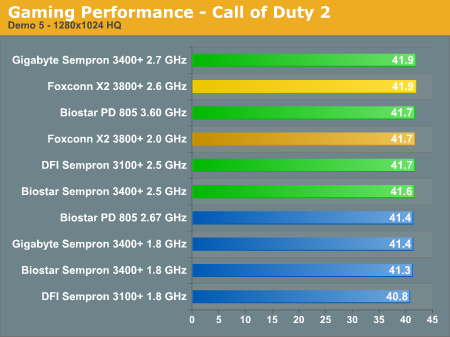
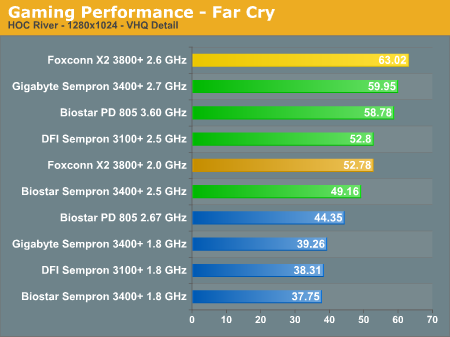
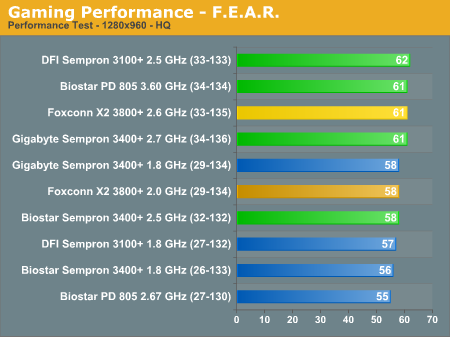
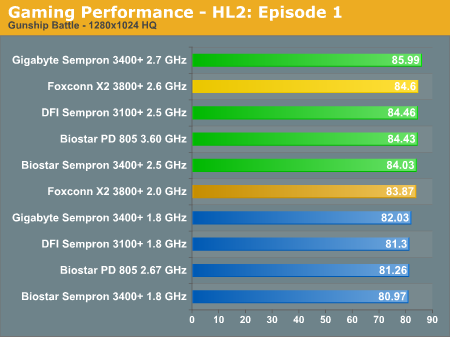
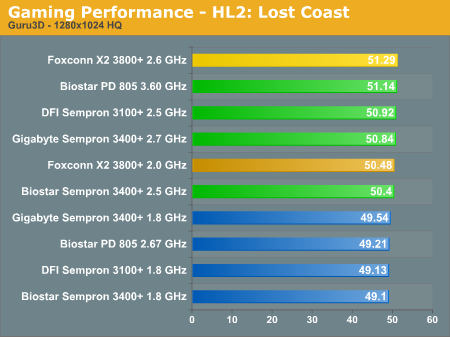
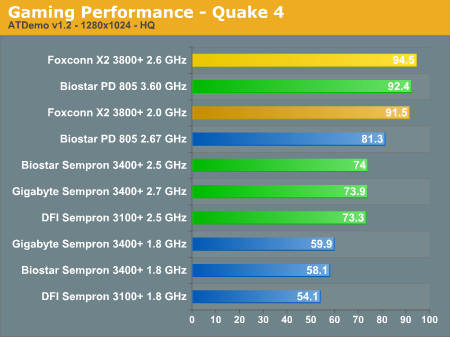

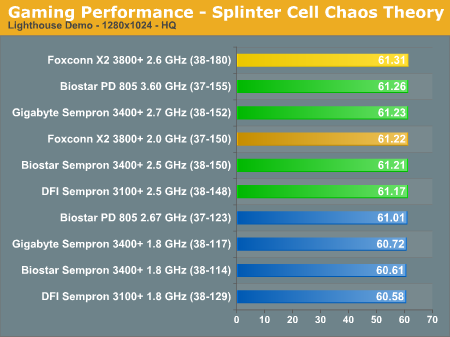
We could have continued running additional benchmarks, but basically it's pretty clear that the 7600 GT has reached its limits in many of the games with the overclocked processors. The good news is that all of the games were very playable at 1280x1024 resolution, so unless you demand things like antialiasing and higher resolutions, this graphics card should be sufficient. In fact, quite a few games can even run well with antialiasing enabled and/or higher resolutions.
Far Cry, Serious Sam 2, Quake 4, and Battlefield 2 all benefit from having a faster processor, but you can see that the graphs begin to flatten out at the top. (We're not quite sure what's going on with the X2 Battlefield 2 performance, but repeated testing garnered the same results. Apparently, that particular game really does well on the X2 chips.) Upcoming titles will likely require more graphics processing power, but in the future you will also be able to upgrade to a faster GPU for less money than that level of performance currently costs. The two SMP aware games that we tested showed differing results. Call of Duty 2 simply taxes the graphics card too much to really benefit from a faster processor. Quake 4 on the other hand shows some significant performance improvements, though once we enabled antialiasing most of those disappeared.
Taking a look at the performance offered by the various platforms, all of the overclocked systems perform very well. Without overclocking, the Sempron AM2 system is surprisingly at the bottom of the list when we used the Biostar motherboard, which is why we also tested with the Gigabyte board. The difference isn't huge, but the Gigabyte board is almost always 3% to 10% faster at the same clock speed and memory settings. This almost certainly points to a less optimized BIOS in the Biostar board, which isn't too surprising as most optimization efforts are focused on the enthusiast motherboards rather than the value offerings.
While historically AMD's K8 architecture has outperformed Intel's NetBurst architecture in games, the Pentium D 805 generally places ahead of the two Sempron chips, even with the slower front side bus. It would appear that the reduced L2 cache on the Sempron chips versus the larger L2 cache on the Pentium D results in the 805 being better overall for gaming. NetBurst has always done very poorly with reduced amounts of L2 cache (just take a look at the performance of the Celeron chips), but with the budget priced Smithfield core Intel jumps back into the lead for this price point.
Looking at the overclocked results again, most of the scores are in line with what we expected. Sempron AM2 is able to surpass Sempron 754 when we're not GPU limited, due at least in part to the higher clock speed we attained. It would also appear that higher clock speeds place more of a burden on system memory, so the dual channel memory comes out ahead. We would expect Sempron AM2 to be better overall, as it runs on a newer platform and we used a more expensive processor. Really, though, if you already have a decent 754 system, upgrading certainly isn't required (yet). If Athlon X2 on socket 939 wasn't enough to get you to upgrade, Athlon X2 on AM2 doesn't change things much.
The big question here is whether or not the CPU is going to be the bottleneck with the selected graphics card. As you'll see, the processor can be a limiting factor in the stock systems, depending on the game, but once we start overclocking everything begins to even out.









We could have continued running additional benchmarks, but basically it's pretty clear that the 7600 GT has reached its limits in many of the games with the overclocked processors. The good news is that all of the games were very playable at 1280x1024 resolution, so unless you demand things like antialiasing and higher resolutions, this graphics card should be sufficient. In fact, quite a few games can even run well with antialiasing enabled and/or higher resolutions.
Far Cry, Serious Sam 2, Quake 4, and Battlefield 2 all benefit from having a faster processor, but you can see that the graphs begin to flatten out at the top. (We're not quite sure what's going on with the X2 Battlefield 2 performance, but repeated testing garnered the same results. Apparently, that particular game really does well on the X2 chips.) Upcoming titles will likely require more graphics processing power, but in the future you will also be able to upgrade to a faster GPU for less money than that level of performance currently costs. The two SMP aware games that we tested showed differing results. Call of Duty 2 simply taxes the graphics card too much to really benefit from a faster processor. Quake 4 on the other hand shows some significant performance improvements, though once we enabled antialiasing most of those disappeared.
Taking a look at the performance offered by the various platforms, all of the overclocked systems perform very well. Without overclocking, the Sempron AM2 system is surprisingly at the bottom of the list when we used the Biostar motherboard, which is why we also tested with the Gigabyte board. The difference isn't huge, but the Gigabyte board is almost always 3% to 10% faster at the same clock speed and memory settings. This almost certainly points to a less optimized BIOS in the Biostar board, which isn't too surprising as most optimization efforts are focused on the enthusiast motherboards rather than the value offerings.
While historically AMD's K8 architecture has outperformed Intel's NetBurst architecture in games, the Pentium D 805 generally places ahead of the two Sempron chips, even with the slower front side bus. It would appear that the reduced L2 cache on the Sempron chips versus the larger L2 cache on the Pentium D results in the 805 being better overall for gaming. NetBurst has always done very poorly with reduced amounts of L2 cache (just take a look at the performance of the Celeron chips), but with the budget priced Smithfield core Intel jumps back into the lead for this price point.
Looking at the overclocked results again, most of the scores are in line with what we expected. Sempron AM2 is able to surpass Sempron 754 when we're not GPU limited, due at least in part to the higher clock speed we attained. It would also appear that higher clock speeds place more of a burden on system memory, so the dual channel memory comes out ahead. We would expect Sempron AM2 to be better overall, as it runs on a newer platform and we used a more expensive processor. Really, though, if you already have a decent 754 system, upgrading certainly isn't required (yet). If Athlon X2 on socket 939 wasn't enough to get you to upgrade, Athlon X2 on AM2 doesn't change things much.










56 Comments
View All Comments
mariush - Thursday, July 13, 2006 - link
88.7 CPU AMD Sempron 3100+67.2 MB Asus K8N4-E-SE
45.2 512Mb DDRAM 400MHz Samsung
85.1 250 GB Maxtor 16Mb SATA II 300 6V250F0 DiamondMax 10 with NCQ
41.9 ASUS DRW-1608P3S
86.1 ASUS EN6600-SILENCER/TD/128
26.3 400 W Generic case
That would be budget.. $440 plus taxes.. and runs any game currently on the market.
JarredWalton - Thursday, July 13, 2006 - link
Runs or runs well? 7600 GT is going to be about 75% faster in GPU-limited benches. 512MB of RAM "runs any game" sure - but some games suck with less than 1GB. Actually, a lot of games suck with only 512MB RAM. Look up about 4 posts for my budget recommendations. Either you don't care about gaming (get IGP), or gaming is important (get at least 7600 GT). Anything else is basically limping along.Kougar - Thursday, July 13, 2006 - link
Thanks for another great article! Really appreciated this one as it answered my Sempron vs 805 vs X2 3800+ curiosity that'd been growing, using the 7600GT no less! No component nitpicking from here! ;)Since ya brought up the E6300, I just wanted to ensure y'all had seen this website that has a authentic 2mb cache version, that included some very lovely benchmarks and even added some E6300 @ 2.4ghz benchmarks to boot. I can't say the revision number of the chip used though to gauge if this was a newer or older not quite as OC-able chip. Er, if I didn't say so before, it's in French, but that's what Google is for! http://www.matbe.com/articles/lire/306/merom-et-co...">Linky
Oh, and I guess while on the subject... NDA lifts for y'all tomorrow right?? ;)
JarredWalton - Thursday, July 13, 2006 - link
Yup. Tomorrow is the big day. :)Paladin165 - Wednesday, July 12, 2006 - link
Jarred, thanks for the guide. It was just what I needed. However I do think it might be interesting to do a kind of "below-budget" guide. Find the cheapest possible system that still runs XP reliably, and uses new, off-the-shelf parts to do it. I do feel like anandtech focuses too much on rather high-end parts. I have to plead with my wife for any part over $50!I mean when you say budget gaming you really mean budget cutting-edge gaming. Don't forget that every game worth playing wasn't made last year...there are thousands of games out there that the integrated GeForce 6100 or 6150 handles fine. Many of these are better than current games, after all there are only one or two really classic games released every year. The only star game on metacritic right now is Oblivion.
I'd like to see what kind of computer you could buy today for $200 or $300 total.
JarredWalton - Thursday, July 13, 2006 - link
Not sure you can really get under $300 without making some serious compromises. I insist on:1GB RAM
DVDR
Everything else is up for change. So let's see....
Socket AM2:
http://labs.anandtech.com/alllinks.php?pfilter=477...">ECS Xpress 300 CrossFire RS485M-M $62
http://labs.anandtech.com/alllinks.php?pfilter=460...">AMD Sempron 3000+ 256KB Manila (1.6 GHz) $62
http://labs.anandtech.com/alllinks.php?pfilter=435...">G.Skill PC-4200 2x512MB Extreme NT $75
http://labs.anandtech.com/alllinks.php?pfilter=436...">BenQ 16X DW1650 $33
http://labs.anandtech.com/alllinks.php?pfilter=172...">Hitachi SATA 3.0Gbps 80GB Deskstar 7K80 $48
http://www.newegg.com/Product/Product.asp?Item=N82...">Generic Linkworld Case + 430W PSU $37
TOTAL = $317
Alternative AM2 Parts:
http://labs.anandtech.com/alllinks.php?pfilter=482...">ECS nForce 410 GeForce 6100 C51GM-M $72
http://labs.anandtech.com/alllinks.php?pfilter=435...">G.Skill PC-5300 2x512MB Extreme LA $85
Socket 754:
http://labs.anandtech.com/alllinks.php?pfilter=418...">MSI nForce 410 GeForce 6100 K8NGM-V $62
http://labs.anandtech.com/alllinks.php?pfilter=293...">AMD Sempron 64 2800+ 256KB Palermo (1.6 GHz) $56
http://labs.anandtech.com/alllinks.php?pfilter=433...">G.Skill PC-3200 1024MB Value NT $84
http://labs.anandtech.com/alllinks.php?pfilter=436...">BenQ 16X DW1650 $33
http://labs.anandtech.com/alllinks.php?pfilter=172...">Hitachi SATA 3.0Gbps 80GB Deskstar 7K80 $48
http://www.newegg.com/Product/Product.asp?Item=N82...">Generic Linkworld Case + 430W PSU $37
TOTAL = $320
Socket 775:
http://labs.anandtech.com/alllinks.php?pfilter=425...">MSI Xpress 200 RC410M-L $68
http://labs.anandtech.com/alllinks.php?pfilter=438...">Intel Pentium D 805 533FSB 2x1MB $114
http://labs.anandtech.com/alllinks.php?pfilter=435...">G.Skill PC-4200 2x512MB Extreme NT $75
http://labs.anandtech.com/alllinks.php?pfilter=436...">BenQ 16X DW1650 $33
http://labs.anandtech.com/alllinks.php?pfilter=172...">Hitachi SATA 3.0Gbps 80GB Deskstar 7K80 $48
http://www.newegg.com/Product/Product.asp?Item=N82...">Generic Linkworld Case + 430W PSU $37
TOTAL = $375
Alternative 775 Parts:
http://labs.anandtech.com/alllinks.php?pfilter=220...">Intel Pentium D 820 800FSB 2x1MB $109 After Rebate ($146 otherwise)
http://labs.anandtech.com/alllinks.php?pfilter=435...">G.Skill PC-5300 2x512MB Extreme LA $85
I spent much more on the Pentium D setup (relatively speaking), but that second CPU core can be extremely helpful. Even without OC'ing, the PD805 is definitely faster than just about any Sempron chip. Run Folding@Home for example, and you can get upwards of 400 PPD compared to about 200 PPD for Sempron chips. However, these are all just general picks and not something I've actually tested or benchmarked. Maybe some of the mobos suck - I don't really know for sure. At $317, the AM2 is a nice pick. No sense in getting 754 for $3 more. $375 for the PD805 system is also quite nice, for a dual core config.
jonp - Wednesday, July 19, 2006 - link
Question:For Socket 775 you list the MSI Xpress 200 RC410M-L motherboard. Neither NewEgg nor MSI show this board compatible with a Pentium D processor. Will the Dual Core Intel Pentium D 805 actually run on this motherboard?
http://www.newegg.com/Product/Product.asp?Item=N82...">http://www.newegg.com/Product/Product.asp?Item=N82...
http://www.msicomputer.com/product/p_spec.asp?mode...">http://www.msicomputer.com/product/p_spec.asp?mode...
JarredWalton - Wednesday, July 19, 2006 - link
That's the problem with trying to cut costs. :| Apparently I screwed up (since this was a quicker post than I'd use for article recommendations). So swap out the MSI board for...Hell, let's go with the ASRock Core 2 compatible model. :) (If you want to overclock, probably go elsewhere!)
http://www.newegg.com/Product/Product.asp?Item=N82...">ASRock 775Dual-VSTA ($64)
I'm stuck looking for an IGP solution for socket 775 that will support Pentium D. Looks like you might need to get a discrete GPU or else stick with Intel 945G chipsets.
midfield - Monday, July 24, 2006 - link
Thanks for the review and comments.I'm wondering if you'd make recommendations on a motherboard for socket 775 which has more SATA ports, or a SATA controller card, and also a full tower case. I'd like to build an OpenSolaris+ZFS disk array server for the home.
Viditor - Monday, July 17, 2006 - link
I'm surprised you didn't include the Asus M2NPV-VM (AM2) in the build...Raid 5 (as well as the usual 0/1/10)
Dual Head (both VGA and DVI) output
HDTV audio and video including RGB
nVidia 6150 graphics
Firewire
GBE
All for under $90...